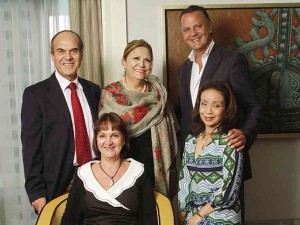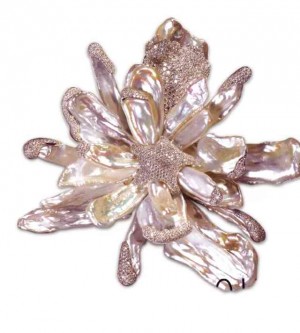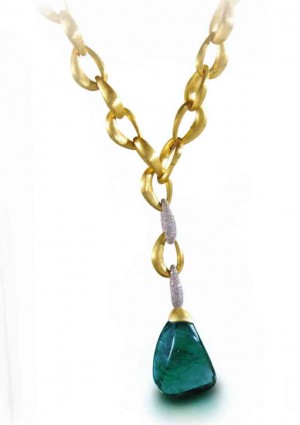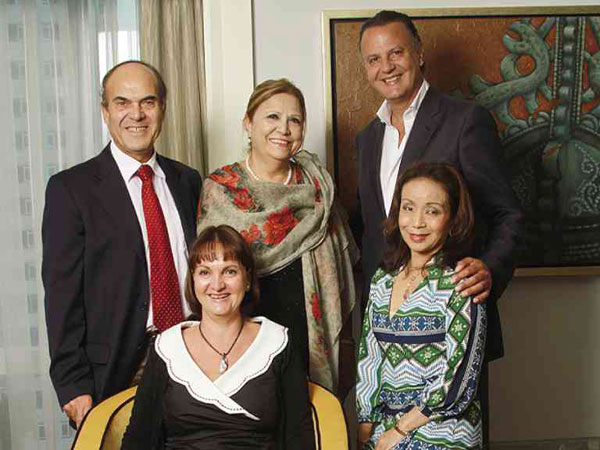
It took 11 years for Israeli couple Isaac and Orna Levy to design an unusual pearl necklace with a canary diamond clasp for its prospective clientele, the royal family of Bahrain. What they waited for was the pendant, made of the largest natural baroque pearl in the world, all of 21 x 27.8 mm. The price: $1.3 million.
Also in their one-of-a-kind collection is a gold and white diamond lariat with a huge 187-karat Columbian emerald, the 11th largest in the world. The price: $2.1 million.
“The [royal family] could buy it and not even blink,” says Isaac, co-founder of Yvel fashion jewelry. (Yvel is their surname spelled backward.)
The Yvel Style Magazine shows Rihanna sporting an adjustable gold lariat with dangling freshwater pearls. Yvel customized it for the singer so it could be worn as choker or a belt.
On another page is fashion icon Carolina Herrera wearing a choker of South Sea pearls in graduating sizes with matching earrings.
“You don’t need to be royalty or a millionaire to wear Yvel,” says Isaac, who is also the marketing whiz in the family. “The pieces could start in the $1,000 to $3,000 range. You feel like royalty with our sapphire earrings, a necklace with keshi pearls or a freshwater pearl ring. People like our designs. They don’t go by the price. Today, a piece of jewelry has a story to tell. Some people want to hear an unusual story while others want a beautiful story without being too expensive.”
Poor cousin no more

Yvel established its reputation by exalting freshwater and baroque pearls into luxury. Once considered the poor cousin of saltwater cultured pearls (those pristine white orbs popularized by Audrey Hepburn and Jackie Onassis), freshwater pearls come in unusual shapes and colors. They take less than six months to cultivate, compared to the cultured pearl which can take years.
The Levys saw the potential of the imperfections and capitalized on their organic shapes to make their designs.
“Most jewelry designers will design a piece of jewelry, then look for the pearl or stone. We first look for the pearl and create the jewelry around it. We let nature be the center of our design, to be enhanced with gold and diamonds,” says Isaac.
Orna adds that freshwater and baroque pearls leave more to the imagination because of their irregularity. “You can create more with something abstract, not with the classic round ones.”
At the recent press launch of Yvel, hosted by its distributor, Rustan’s, Orna wore a necklace made up of swirls of white and black diamonds. Hanging on it was a 15-mm baroque pearl pendant. She also wore a ring—a large freshwater pearl with a dainty gold side ribbon.
Yvel’s unconventional designs attracted the Rustan’s buyers at the Baselworld Jewelry and Watch Show in Switzerland. When Rustan’s started testing the market with a few pieces, the items were sold immediately.
At Baselworld, Yvel’s sapphire necklace caught the eye of Rustan’s president Zenaida Tantoco herself. It belonged to Yvel’s sapphire rainbow collection, so-called because the sapphire stones were in various hues other than blue—from gray to old rose, even celadon. They were mined in Namibia, which is famous for its sapphires.
Signature look
The Levys’ foray into jewelry was the result of both family heritage and passion.

Orna is a fourth-generation jeweler, a descendant of the world-famous Moussaieff clan of jewelers. Migrating from Uzbekistan to Jerusalem, her great-grandfather, a goldsmith, set up a jewelry store. A century ago, her grandfather introduced Japanese pearls to the Israeli market. Her mother, Hannah Eliab, is one of Israel’s top jewelers and her uncle, Israeli multimillionaire Shlomo Moussaieff, is founder of the Moussaieff Jewelry Ltd. in London, which caters to royalty.
With a capital of $2,000, the Levys bought stones and pearls from Hannah. “I remember asking my wife what she can do. She said she could string pearls,” Levy recalls their modest start.
Since South Sea pearls were way beyond their budget, the Levys started stringing freshwater pearls with gold beads and semiprecious stones such as lapis lazuli, coral, onyx and turquoise.
In 1986, the company was founded under the name Isaac Jewelers. Through time, it evolved with gold and precious stones. When the company started going international, it was renamed Yvel.
In 1991, a Jewish-American senator’s wife, Casey Ribicoff, introduced the Levys to news anchor Barbara Walters, who immediately liked their pieces. She, in turn, introduced them to Bette Midler.
Since then, Yvel has been patronized by such celebrities as Debra Messing, Isla Fisher and Barbra Streisand. Soon, department stores started carrying Yvel.
Distinguished, artistic
The core of the Yvel signature look is the unexpected. “When I meet a woman, regardless if she is royalty, a celebrity or my kind, they say, ‘I’ve seen everything.’ This is when I pull out the new designs,” says Isaac. “They see that Yvel is more distinguished, artistic, unusual and not in-your-face. Even the expensive pieces are not in-your-face,” says Isaac.
Another Yvel signature is the setting of matte gold finish. “Israel is mostly desert. We live in Jerusalem which is close to the Judea desert. Our jewelry evokes the desert because of the gold’s texture. It’s not shiny or glitzy, but subtle and matte.”
Yvel is for the adventurous wearer. “We set the trend,” maintains Orna. “We are not known for round pearl necklaces. Isaac and I go to pearl farms and auctions to buy pearls. We look for the striking color and shapes.”
This year, Yvel launched the Soufflé pearl, which is lighter than most cultured pearls and flatter. The big hit is the Piano Bracelet, inspired by keyboards. It is not only weightless, but the back of the jewelry is also just as fastidiously assembled as the front.
Turning point

It took two decades before Yvel started winning awards. In 2005, a brooch made of keshi pearl blossoms and white diamonds coming out of an elongated stem won for them the Town & Country Couture Design Award for “Best in Pearl Design.” The award is considered the Oscars of the fine jewelry industry.
Of all its winning designs, the Levys favor the blossoming floral brooch with petals made of wild freshwater pearls and white diamonds.
“When Orna and I saw the pearls in an auction, we both thought that they could make a flower coming out from a bed of pearls. It became a 3D brooch,” says Isaac.
The exotic piece won for them the Town & Country Couture Design Award for “Best in Pearl Design” in 2007.
The awards are just icing on the cake. Isaac cites the Yvel Design Center in 2010 as their turning point. The Levys invested $8 million to transform a historic, 160-year-old winery into their headquarters. The place has become a tourist destination as well.
“We had achieved our vision of creating a place for the Levy family and for sharing our luck and success with over 100 employees whom we call the Yvel family. They spend more time at the design center than in their home. That’s why it’s a home to them as much as it is a home to us,” says Issac.
Waxing philosophical, he declares: “We don’t define success by the externals but by genuine growth inside and happiness.”
Isaac is also a believer in giving back. The couple are flying to El Nido for a holiday, then to Cebu where they could buy furniture. Since the Philippines has been a good market for their jewelry, they deem it right to patronize the country’s products.









































